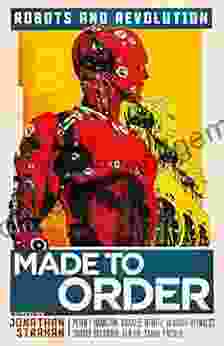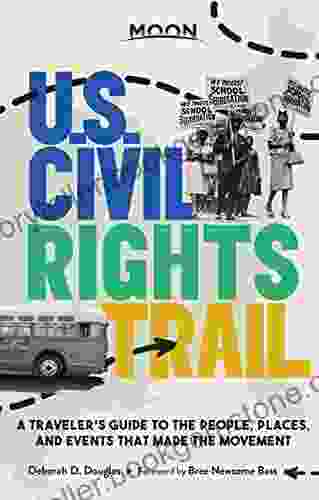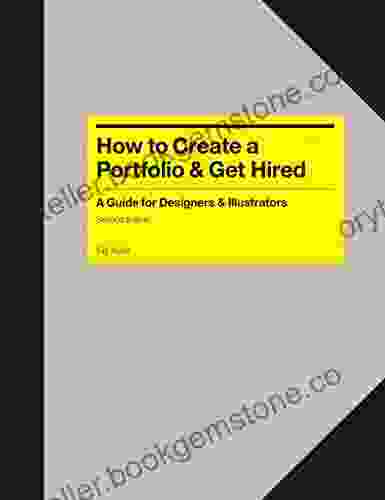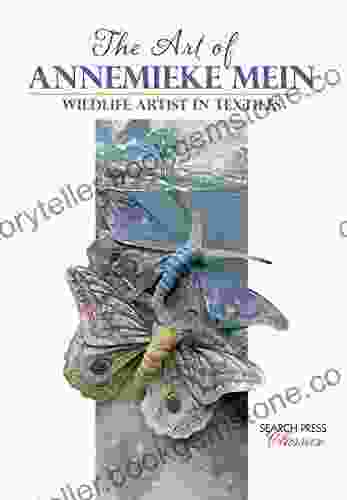The Ultimate Guide to Creating a Portfolio Site That Gets You Hired, Second Edition

In today's competitive job market, having a strong online portfolio is essential for getting hired. A well-designed portfolio site can showcase your skills, experience, and accomplishments in a way that makes you stand out from the crowd. But creating a portfolio site that gets you hired is not as simple as just throwing together a few of your best projects.
There is a lot of thought and planning that goes into creating a portfolio site that is effective. In this guide, we will walk you through the entire process of creating a portfolio site, from start to finish. We will cover everything from choosing the right domain name and hosting provider to designing your site and writing your content.
4.4 out of 5
| Language | : | English |
| File size | : | 17941 KB |
| Text-to-Speech | : | Enabled |
| Screen Reader | : | Supported |
| Enhanced typesetting | : | Enabled |
| Print length | : | 282 pages |
1. Choose the Right Domain Name
The first step in creating a portfolio site is to choose a domain name. Your domain name is the address of your website on the internet. It is important to choose a domain name that is easy to remember and relevant to your brand.
If you are a designer, you may want to choose a domain name that includes the word "design" or "portfolio." For example, a good domain name for a designer might be www.johndoeportfolio.com.
If you are a developer, you may want to choose a domain name that includes the word "development" or "web." For example, a good domain name for a developer might be www.janedoeweb.com.
Once you have chosen a domain name, you need to register it with a domain registrar. There are many different domain registrars available, so you can shop around for the best price.
2. Choose a Hosting Provider
Once you have registered your domain name, you need to choose a hosting provider. A hosting provider is a company that stores the files for your website on its servers. There are many different hosting providers available, so you can shop around for the best price and features.
When choosing a hosting provider, there are a few things you should keep in mind:
- Uptime: The uptime of a hosting provider is the percentage of time that their servers are up and running. You want to choose a hosting provider with a high uptime so that your website is always accessible to visitors.
- Bandwidth: The bandwidth of a hosting provider is the amount of data that can be transferred to and from their servers each month. You want to choose a hosting provider with enough bandwidth to handle the traffic to your website.
- Storage space: The storage space of a hosting provider is the amount of space on their servers that is available for your website files. You want to choose a hosting provider with enough storage space to accommodate your website's files.
- Customer support: The customer support of a hosting provider is the level of support that they provide to their customers. You want to choose a hosting provider with good customer support so that you can get help if you need it.
3. Design Your Site
Once you have chosen a domain name and a hosting provider, you can start designing your site. The design of your site is important because it will impact how visitors perceive your brand.
There are a few things you should keep in mind when designing your site:
- Layout: The layout of your site should be easy to navigate and visually appealing. You want to make it easy for visitors to find the information they are looking for.
- Color scheme: The color scheme of your site should be consistent with your brand. You want to choose colors that are complementary and that create a positive impression.
- Typography: The typography of your site should be easy to read and visually appealing. You want to choose fonts that are complementary and that are appropriate for the tone of your site.
- Imagery: The imagery on your site should be high-quality and relevant to your brand. You want to choose images that are visually appealing and that help to tell your story.
4. Write Your Content
The content on your site is just as important as the design. The content is what will inform visitors about your skills, experience, and accomplishments.
When writing your content, there are a few things you should keep in mind:
- Clarity: The content on your site should be clear and concise. You want to make it easy for visitors to understand what you are saying.
- Conciseness: The content on your site should be concise. You want to get your point across without using unnecessary words.
- Accuracy: The content on your site should be accurate. You want to make sure that the information you are providing is correct.
- Relevance: The content on your site should be relevant to your brand. You want to make sure that the information you are providing is relevant to your skills, experience, and accomplishments.
5. Promote Your Site
Once you have created your portfolio site, you need to promote it so that people can find it. There are a few different ways to promote your site:
- Social media: Social media is a great way to promote your portfolio site. You can share your portfolio site on social media platforms like Twitter, Facebook, and LinkedIn.
- Search engine optimization (SEO): SEO is the practice of optimizing your website so that it ranks higher in search engine results pages (SERPs). You can improve your SEO by using relevant keywords in your content and by building backlinks to your site.
- Networking: Networking is a great way to meet new people and promote your portfolio site. You can attend industry events and meetups, and you can connect with people on LinkedIn.
Creating a portfolio site that gets you hired is not as simple as just throwing together a few of your best projects. There is a lot of thought and planning that goes into creating a portfolio site that is effective.
By following the steps outlined in this guide, you can create a portfolio site that showcases your skills, experience, and accomplishments in a way that makes you stand out from the crowd. You can also promote your site so that people can find it and learn more about your work.
So what are you waiting for? Get started on creating your portfolio site today!
4.4 out of 5
| Language | : | English |
| File size | : | 17941 KB |
| Text-to-Speech | : | Enabled |
| Screen Reader | : | Supported |
| Enhanced typesetting | : | Enabled |
| Print length | : | 282 pages |
Do you want to contribute by writing guest posts on this blog?
Please contact us and send us a resume of previous articles that you have written.
 Best Book
Best Book Page Flip
Page Flip Bookshelf
Bookshelf Literary loom
Literary loom Chapter
Chapter Bookish
Bookish PageTurner
PageTurner Bibliophile
Bibliophile Story
Story Inkwell
Inkwell Bookworm
Bookworm Labyrinth
Labyrinth Plot Twist
Plot Twist Prose
Prose Paperback
Paperback Storyteller
Storyteller Sanctuary
Sanctuary Fiction
Fiction Reading
Reading Chronicle
Chronicle Read
Read Avanti Centrae
Avanti Centrae Bella Martin
Bella Martin Anthony Slide
Anthony Slide Talia Beckett
Talia Beckett Riva Lehrer
Riva Lehrer Jan Morris
Jan Morris Jennifer Homans
Jennifer Homans Wakefield Poole
Wakefield Poole Gayatri Gopinath
Gayatri Gopinath S H Jucha
S H Jucha Anthony David
Anthony David Carne Griffiths
Carne Griffiths Aziz Shihab
Aziz Shihab Nancy Nicholson
Nancy Nicholson Anne Morrow Lindbergh
Anne Morrow Lindbergh Annette Freeman
Annette Freeman Arthur Conan Doyle
Arthur Conan Doyle Emma Read
Emma Read Charles Taliaferro
Charles Taliaferro Mark Edward Harris
Mark Edward Harris Nick Cole
Nick Cole Kyunghee Pyun
Kyunghee Pyun Anthony C Winkler
Anthony C Winkler Stewart James
Stewart James Jodi Ohl
Jodi Ohl Chloe Fox
Chloe Fox Anton Treuer
Anton Treuer B B Thatcher
B B Thatcher Graham Fraser
Graham Fraser Elizabeth Friendship
Elizabeth Friendship Rosemary Sullivan
Rosemary Sullivan Edgar Degas
Edgar Degas Francesca Fiorani
Francesca Fiorani Rob Schmitz
Rob Schmitz Heather Vogel Frederick
Heather Vogel Frederick Katja Pantzar
Katja Pantzar Lorraine Caputo
Lorraine Caputo Pamela Des Barres
Pamela Des Barres Tim Gunn
Tim Gunn Pat Hall
Pat Hall Elise Darcy
Elise Darcy John Izbicki
John Izbicki Paul Holt
Paul Holt Christopher Simmons
Christopher Simmons Annie Ernaux
Annie Ernaux Kirsten Anderson
Kirsten Anderson Koji A Dae
Koji A Dae Ariana Godoy
Ariana Godoy Anne Keenan Higgins
Anne Keenan Higgins Gail Morin
Gail Morin Binka Le Breton
Binka Le Breton Vladimir London
Vladimir London Atsons
Atsons Jim Steinmeyer
Jim Steinmeyer Mackinley Helm
Mackinley Helm Avery Blake
Avery Blake Anthea Sharp
Anthea Sharp Blackhorse Mitchell
Blackhorse Mitchell Anne De Courcy
Anne De Courcy Tim Downs
Tim Downs Ray Bradbury
Ray Bradbury Clive Hallett
Clive Hallett Olive Collins
Olive Collins Karen Ordahl Kupperman
Karen Ordahl Kupperman Anthony Ryan
Anthony Ryan S C Jensen
S C Jensen Jay Caspian Kang
Jay Caspian Kang George Rathmell
George Rathmell Elizabeth Bard
Elizabeth Bard Vanessa Hua
Vanessa Hua Tamron Hall
Tamron Hall Linda Furiya
Linda Furiya Nicole Casey
Nicole Casey Anthony J Melchiorri
Anthony J Melchiorri Philip Tyler
Philip Tyler Nancy Lee Mccaskill
Nancy Lee Mccaskill Gene D Phillips
Gene D Phillips Jane Yolen
Jane Yolen James Maskalyk
James Maskalyk Scott Westerfeld
Scott Westerfeld Jay Boyce
Jay Boyce Ashley Bristowe
Ashley Bristowe Eric Broudy
Eric Broudy Jose Antonio Salgado Alonso
Jose Antonio Salgado Alonso Morgan Rogers
Morgan Rogers Paul Steinberg
Paul Steinberg Peter Watts
Peter Watts Bill White
Bill White Anne Richardson Williams
Anne Richardson Williams Christopher Griffin
Christopher Griffin Magi Nams
Magi Nams Xiaolu Guo
Xiaolu Guo Ernst Lehner
Ernst Lehner Steven Bradley
Steven Bradley August Wilson
August Wilson H Dolmetsch
H Dolmetsch Brendan Edwards
Brendan Edwards Jane Monteith
Jane Monteith Deborah Paris
Deborah Paris Annemarie Strehl
Annemarie Strehl Howard Dully
Howard Dully Arielle Silverman Ph D
Arielle Silverman Ph D Carolyn Jenkins
Carolyn Jenkins Diana Kupershmit
Diana Kupershmit Avery Grey
Avery Grey Rebecca Serle
Rebecca Serle Michael Frank
Michael Frank Tia Williams
Tia Williams Peter F Hamilton
Peter F Hamilton Laura Davis Chanin
Laura Davis Chanin Shonda Buchanan
Shonda Buchanan Jt Sawyer
Jt Sawyer Sue Miller
Sue Miller Deborah D Douglas
Deborah D Douglas Sarah Vallance
Sarah Vallance Chris Saper
Chris Saper Charles Nordhoff
Charles Nordhoff Antonis Tsagaris
Antonis Tsagaris Geoff Schumacher
Geoff Schumacher Chawadee Nualkhair
Chawadee Nualkhair Shugri Said Salh
Shugri Said Salh Haben Girma
Haben Girma Brian Butko
Brian Butko Wade Motawi
Wade Motawi Mary Maccracken
Mary Maccracken John H Groberg
John H Groberg Beth Haslam
Beth Haslam Kevin Mannens
Kevin Mannens Tracy Franz
Tracy Franz Paul Brinkley Rogers
Paul Brinkley Rogers Robert J Serling
Robert J Serling Howling Moon Books
Howling Moon Books Scott M Madden
Scott M Madden Arthur Miller
Arthur Miller Annette Kowalski
Annette Kowalski Luke Nguyen
Luke Nguyen John Scarne
John Scarne Maxine Leeds Craig
Maxine Leeds Craig Austin Channing Brown
Austin Channing Brown Robert Beverly Hale
Robert Beverly Hale Sara Paretsky
Sara Paretsky Ashley Jaquavis
Ashley Jaquavis Anne Frank
Anne Frank Mary Kay Ricks
Mary Kay Ricks Keller Easterling
Keller Easterling Robert V Camuto
Robert V Camuto Arthur C Clarke
Arthur C Clarke Apsley Cherry Garrard
Apsley Cherry Garrard J R Osborn
J R Osborn Karl Ove Knausgaard
Karl Ove Knausgaard Ansel Adams
Ansel Adams W A Bentley
W A Bentley Vernor Vinge
Vernor Vinge Ashley Brantley
Ashley Brantley Peter James West
Peter James West Kris Jenner
Kris Jenner Samantha Hahn
Samantha Hahn Sadhna Shanker
Sadhna Shanker Jasper T Scott
Jasper T Scott Tim Z Hernandez
Tim Z Hernandez Martin Kemp
Martin Kemp Prenisha Aja
Prenisha Aja Smauggy Universe
Smauggy Universe Julie Nelson Davis
Julie Nelson Davis W Michael Blumenthal
W Michael Blumenthal Valerie Biden Owens
Valerie Biden Owens B Russell Mcconkie
B Russell Mcconkie Marta Mcdowell
Marta Mcdowell Edgar Rice Burroughs
Edgar Rice Burroughs David Deal
David Deal Blaze Ward
Blaze Ward Lizzie Williams
Lizzie Williams Anne Sebba
Anne Sebba Ken Seeroi
Ken Seeroi George Huppert
George Huppert Anthony M Strong
Anthony M Strong Zharel Anger
Zharel Anger Phil Doran
Phil Doran Tay Mo Nae
Tay Mo Nae Thomas M Hill
Thomas M Hill Arielle Eckstut
Arielle Eckstut Caroline Montague
Caroline Montague Quentin Tarantino
Quentin Tarantino Waldo Rodriguez
Waldo Rodriguez Lonely Planet
Lonely Planet Yasmin Angoe
Yasmin Angoe Arnold Rampersad
Arnold Rampersad Meyer Berger
Meyer Berger Ursa Dax
Ursa Dax Stephen Moss
Stephen Moss Annette Gordon Reed
Annette Gordon Reed King Ellie
King Ellie Pat Cadigan
Pat Cadigan Tiffany Roberts
Tiffany Roberts Anthony M Amore
Anthony M Amore Oliver Mayes
Oliver Mayes Mary Renault
Mary Renault Eugenio Barba
Eugenio Barba Saeed Jones
Saeed Jones Rivers Solomon
Rivers Solomon Tara Wells
Tara Wells James Rosone
James Rosone Jason Louis
Jason Louis Peter Turchi
Peter Turchi Fig Taylor
Fig Taylor David Larocca
David Larocca Oscar Zeta Acosta
Oscar Zeta Acosta Kristen Ashley
Kristen Ashley John E Siers
John E Siers Asaf Messerer
Asaf Messerer Annemarie Bean
Annemarie Bean Tracy Birdsall
Tracy Birdsall Beverly Galeskas
Beverly Galeskas Margaret Walker
Margaret Walker Michael Chatfield
Michael Chatfield Kim Knox
Kim Knox Hanife Hassan O Keeffe
Hanife Hassan O Keeffe Jane Sullivan
Jane Sullivan Ari Seth Cohen
Ari Seth Cohen Miss Jenesequa
Miss Jenesequa Elizabeth David
Elizabeth David Anne Rice
Anne Rice Jaime Castle
Jaime Castle Donald Murray
Donald Murray Peter Jazwinski
Peter Jazwinski Marlene Wagman Geller
Marlene Wagman Geller Anton Hager
Anton Hager Noy
Noy Bwwm Love
Bwwm Love Madeleine Walker
Madeleine Walker Gloria Mattioni
Gloria Mattioni Patricia Williams
Patricia Williams De Andrea
De Andrea Jacqueline Rayner
Jacqueline Rayner David E Stannard
David E Stannard Eric Warren
Eric Warren Stephan Talty
Stephan Talty Eileen Mcnamara
Eileen Mcnamara R G Collingwood
R G Collingwood Wesley B Turner
Wesley B Turner Yuk Hui
Yuk Hui Karen A Romanko
Karen A Romanko Anne Green Gilbert
Anne Green Gilbert Kaitlyn Greenidge
Kaitlyn Greenidge Robert Graysmith
Robert Graysmith Robert D Kaplan
Robert D Kaplan Robert Dugoni
Robert Dugoni Juliette Sobanet
Juliette Sobanet Erin Eitter Kono
Erin Eitter Kono Kindle Edition
Kindle Edition Tamar Diana Wilson
Tamar Diana Wilson Pamela Cutter
Pamela Cutter Pankaj Mishra
Pankaj Mishra Nnedi Okorafor
Nnedi Okorafor Benjamin Percy
Benjamin Percy Debbie Macomber
Debbie Macomber D Levesque
D Levesque Lena Grey
Lena Grey Margaret Scott
Margaret Scott Eric Campbell
Eric Campbell Zeneba Bowers
Zeneba Bowers Jason Waguespack
Jason Waguespack Arlo Adams
Arlo Adams Zalmay Khalilzad
Zalmay Khalilzad Joe Abercrombie
Joe Abercrombie Rebecca Kaye
Rebecca Kaye Art Wolfe
Art Wolfe Ayn Rand
Ayn Rand Tony Peak
Tony Peak Arthur Murray
Arthur Murray Martin Cruz Smith
Martin Cruz Smith John Woolf
John Woolf Anton Chekhov
Anton Chekhov Beata Lubas
Beata Lubas Lydia Wilen
Lydia Wilen Antony Kamm
Antony Kamm Ron Stocke
Ron Stocke Jan Cohen Cruz
Jan Cohen Cruz Myrnoska Scott
Myrnoska Scott Valerie Mckeehan
Valerie Mckeehan Catherine E Mckinley
Catherine E Mckinley Woody Allen
Woody Allen John H Clark Iii
John H Clark Iii Suzanne Fredericq
Suzanne Fredericq Chris A Norton
Chris A Norton Tony Hillerman
Tony Hillerman Ashley Antoinette
Ashley Antoinette T R Todd
T R Todd Annie Keary
Annie Keary New Edition Kindle Edition
New Edition Kindle Edition Kim Erwin
Kim Erwin Leokadia Schmidt
Leokadia Schmidt Rebecca Keegan
Rebecca Keegan Michael Fleishman
Michael Fleishman Satyajit Ray
Satyajit Ray Jeffrey Vonk
Jeffrey Vonk Shami Stovall
Shami Stovall Artemisia Gentileschi
Artemisia Gentileschi Gina Rossi Armfield
Gina Rossi Armfield Elena M Watson
Elena M Watson Angela Y Davis
Angela Y Davis Laurel Ann Francis
Laurel Ann Francis B V Larson
B V Larson Ashley Fiolek
Ashley Fiolek Asali Solomon
Asali Solomon Ashleynicole
Ashleynicole Annette Dozier
Annette Dozier Janet Farnsworth
Janet Farnsworth Clare Therese Gray
Clare Therese Gray Joseph Wambaugh
Joseph Wambaugh Joseph Mcbride
Joseph Mcbride Ruth Wariner
Ruth Wariner Kathy Kolbe
Kathy Kolbe Julian Stallabrass
Julian Stallabrass Jun Maeda
Jun Maeda Anwei Skinsnes Law
Anwei Skinsnes Law Nathan Deuel
Nathan Deuel Marina Garone Gravier
Marina Garone Gravier R A Lafferty
R A Lafferty Arthur Bartow
Arthur Bartow Matthew A Goodwin
Matthew A Goodwin Obed Silva
Obed Silva Michael Betancourt
Michael Betancourt Kao Kalia Yang
Kao Kalia Yang Scott Lerman
Scott Lerman Todd Barry
Todd Barry Richard Killeen
Richard Killeen Brian W Smith
Brian W Smith Franklin Horton
Franklin Horton Edward Achorn
Edward Achorn Laurence Oliphant
Laurence Oliphant Claire Devarrieux
Claire Devarrieux Antonia Fraser
Antonia Fraser Anthony Jones
Anthony Jones John Davidson
John Davidson Jesse Martin
Jesse Martin Bear Heart
Bear Heart Sarah Winnemucca Hopkins
Sarah Winnemucca Hopkins Sari Botton
Sari Botton Matthew Jm Carpenter
Matthew Jm Carpenter Richard Pikesley
Richard Pikesley Steven M Nolt
Steven M Nolt Anne Hillerman
Anne Hillerman Arrigo Cipriani
Arrigo Cipriani Pico Iyer
Pico Iyer Arleta Pech
Arleta Pech Berlitz Publishing
Berlitz Publishing Arthur C Danto
Arthur C Danto Ashley K Stoyanov Ojeda
Ashley K Stoyanov Ojeda Barbara Demarco Barrett
Barbara Demarco Barrett Mary Ann Scott
Mary Ann Scott Annette Insdorf
Annette Insdorf Sheila O Flanagan
Sheila O Flanagan Arne Dehli
Arne Dehli Ashley Mahlberg
Ashley Mahlberg Bob Mayer
Bob Mayer Dirk Hayhurst
Dirk Hayhurst Cathy Curtis
Cathy Curtis Mark Baskinger
Mark Baskinger Anne Mccaffrey
Anne Mccaffrey Nora Roberts
Nora Roberts Joan Bess
Joan Bess Joe Russo
Joe Russo Colonial Williamsburg Foundation
Colonial Williamsburg Foundation Christine Denniston
Christine Denniston Colby Buzzell
Colby Buzzell Chris Weyers
Chris Weyers Ava Archer
Ava Archer Anne Lister
Anne Lister Ashlee Vance
Ashlee Vance Jean Guerrero
Jean Guerrero Billy Connolly
Billy Connolly Hannah Arendt
Hannah Arendt Jay Allan
Jay Allan Colin Angus
Colin Angus Lutishia Lovely
Lutishia Lovely Detlev Henschel
Detlev Henschel Jan Murphy
Jan Murphy Lian Hearn
Lian Hearn Arthur H Buckley
Arthur H Buckley Joan Baxter
Joan Baxter Anne Manera
Anne Manera Aubrey A Jones
Aubrey A Jones Darby English
Darby English Cynthia Winton Henry
Cynthia Winton Henry Annemieke Mein
Annemieke Mein Chris Cozen
Chris Cozen Haruki Murakami
Haruki Murakami Doug Peterson
Doug Peterson Jason Frye
Jason Frye Michael Evamy
Michael Evamy Doug Scott
Doug Scott Armin Weber
Armin Weber Nicholas Sansbury Smith
Nicholas Sansbury Smith David Consuegra
David Consuegra John Triptych
John Triptych N L Hudson
N L Hudson B Ruby Rich
B Ruby Rich Michael Tucker
Michael Tucker Destiny Davis
Destiny Davis Regina Held
Regina Held Linda Nagata
Linda Nagata Kalyn Franke
Kalyn Franke Armine Von Tempski
Armine Von Tempski Approach Guides
Approach Guides Lorna Luft
Lorna Luft George Bird Grinnell
George Bird Grinnell Walt Bachman
Walt Bachman Doris Marjorie Moore
Doris Marjorie Moore Patrick Rothfuss
Patrick Rothfuss Austin Howe
Austin Howe Frank Conroy
Frank Conroy Anthony James
Anthony James Mimi Kwa
Mimi Kwa Anthony Ryder
Anthony Ryder Joan Tollifson
Joan Tollifson Lou Sutton
Lou Sutton Michael Jan Friedman
Michael Jan Friedman Tony Randgaard
Tony Randgaard Anne Moody
Anne Moody Anton Tekshin
Anton Tekshin Carl Stubblefield
Carl Stubblefield Axel Hacke
Axel Hacke Dennic Chunman Lo
Dennic Chunman Lo Fifi O Neill
Fifi O Neill Br Kingsolver
Br Kingsolver Antoinette Nora Claypoole
Antoinette Nora Claypoole Owen Jones
Owen Jones Joseph Birchall
Joseph Birchall Jonathan Strahan
Jonathan Strahan Pearl Howie
Pearl Howie Asimina Nteliou
Asimina Nteliou Karen Mccartney
Karen Mccartney James D Umbach
James D Umbach Betty Reynolds
Betty Reynolds Scott Hughey
Scott Hughey Maureen T Corrigan
Maureen T Corrigan Fergal Keane
Fergal Keane Dave Bartell
Dave Bartell Bernadette Murphy
Bernadette Murphy Ariel Dorfman
Ariel Dorfman Sarah Crafts
Sarah Crafts Davida Schulman
Davida Schulman Maria Venegas
Maria Venegas M N Forgy
M N Forgy Sonia Misra
Sonia Misra John A Crespi
John A Crespi Ar Corbin
Ar Corbin Anton Roux
Anton Roux Christopher Sieving
Christopher Sieving Michael Kimmelman
Michael Kimmelman
Light bulbAdvertise smarter! Our strategic ad space ensures maximum exposure. Reserve your spot today!
 Braden WardFollow ·12.5k
Braden WardFollow ·12.5k Jean BlairFollow ·14.9k
Jean BlairFollow ·14.9k Elliott CarterFollow ·4.1k
Elliott CarterFollow ·4.1k Eddie PowellFollow ·10.1k
Eddie PowellFollow ·10.1k Shaun NelsonFollow ·17.4k
Shaun NelsonFollow ·17.4k Chase MorrisFollow ·10.2k
Chase MorrisFollow ·10.2k Rex HayesFollow ·6.9k
Rex HayesFollow ·6.9k Thomas HardyFollow ·11.2k
Thomas HardyFollow ·11.2k

 Braden Ward
Braden WardMade to Order Robots and the Coming Revolution
Robots are becoming increasingly common...

 Clay Powell
Clay Powell1971: A Year in the Life of Color
The year 1971 was a pivotal one for color....

 Ralph Waldo Emerson
Ralph Waldo EmersonTech World's Undying Mercenaries: A Deep Dive into the...
In the ever-evolving landscape of the...

 Wade Cox
Wade CoxThe Ultimate Traveler's Guide to the People, Places, and...
Travel has always been a part of the human...

 Evan Simmons
Evan SimmonsA Comprehensive Guide: Uncovering Small Town Culinary...
: A Culinary Odyssey Beyond the City...
4.4 out of 5
| Language | : | English |
| File size | : | 17941 KB |
| Text-to-Speech | : | Enabled |
| Screen Reader | : | Supported |
| Enhanced typesetting | : | Enabled |
| Print length | : | 282 pages |














